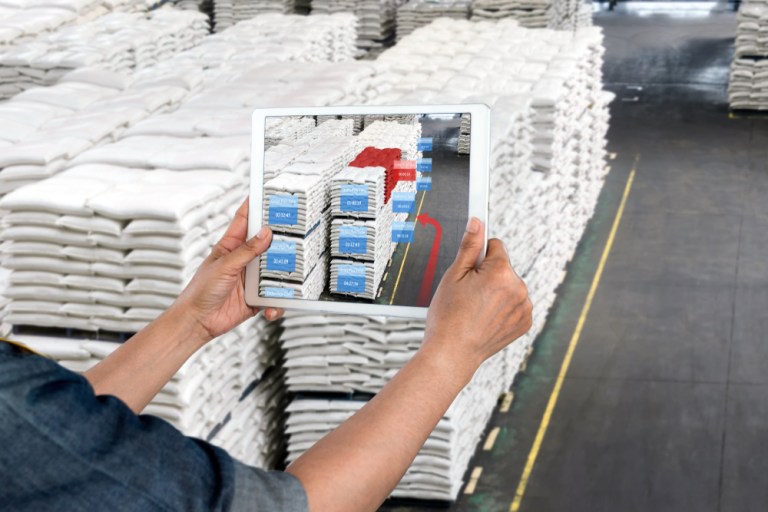Augmented reality (AR) is quickly proving to be a technology about more than video games as the enterprise gets creative in how to use AR for customer engagement. PayPal announced earlier this year that it would revive an old patent that deploys AR to display product information while consumers shop in-store. Facebook said earlier this month that it is testing AR advertising in its News Feed. And L’Oréal recently unveiled its AR-powered makeup assistant to help users virtually test out products.
The possibilities are vast, and businesses are excited. A survey published from ABI Research last year found 75 percent of companies are interested in implementing AR tech at some point in the future. But these recent examples of AR implementation demonstrate the imbalance in adoption, with consumer-facing projects unequivocally beating out B2B use cases for the technology. That could be changing, however.
“AR shouldn’t be underestimated,” said Pieterjan Bouten, CEO of B2B sales solutions provider Showpad. “And while the biggest applications of AR that we’ve seen up to this point have been more consumer-facing, like Snapchat and Pokémon Go, we can expect to see more AR applications in the enterprise.”
In its 2018 Augmented and Virtual Reality Survey Report released in March, Perkins Coie noted an intriguing trend. The gaming sector is unsurprisingly the vertical most attracted to AR investments in the coming months, but its lead over other industries weakened compared to a 2016 survey, with education and healthcare/medical devices gaining strength in investment plans.
ABI Research’s report examined how B2B businesses are exploring AR, and found manufacturing to have the widest adoption of AR technologies so far.
For Showpad, manufacturing is a key focus. The company recently announced new AR functionalities for its services, which enable suppliers selling complex and large equipment, machinery and other products to use AR technology to more accurately show offerings to potential customers, and allow those clients to interact with those tools in a digital format. According to Bouten, the potential here is significant, but AR adoption in B2B settings remains muted. He cited data from Apple, which revealed only 2,000 of more than 3 million apps in its App Store have currently enabled use of Apple’s ARKit.
Advertisement: Scroll to Continue
ABI Research emphasized lagging adoption of AR, finding that though 75 percent of survey respondents across a range of B2B verticals — including manufacturing and logistics — show interest, only 25 percent have already adopted the technology. ABI Research Principal Analyst Eric Abbruzzese said in a statement that ongoing pilots of AR solutions aren’t expected to see implementation and scale for another year or two.
According to Bouten, B2B firms are missing out when they lag in adoption of augmented reality.
“This presents a huge opportunity for organizations to differentiate themselves, as this feature has barely been taken advantage of, especially in B2B settings,” he said. “It presents an opportunity to deliver a better, more immersive buyer experience by showing buyers virtual products within the context of their actual environment.”
That’s largely the motivation behind B2C retail’s excitement over the technology. But as B2B commerce follows in B2C’s path, corporate buyers are wanting the same enhanced experiences.
“Today’s B2B buyers are acting more like consumers,” said Bouten. “Buyers want to see and interact with products before purchasing to know how they will fit into their organizations.”
The potential in B2B sales may be even larger, considering the industry’s need for innovation and coupled with the types of products and machines corporate buyers must consider, which present very different challenges to the shopping experience than would be encountered in a B2C retail setting. Bouten noted that B2B suppliers continue to use outdated product descriptions, driving buyers to search product information solo.
“This directs the sales conversation away from suppliers, who ultimately lose out on sales with qualified prospects,” he said.
Key to B2B eCommerce’s adoption of AR is the expansion of user-friendly ways to apply the tool. Bouten pointed to Apple’s ARKit and Google‘s ARCore, which “have solved the biggest problem keeping AR from truly entering the mainstream” by making it easier for developers to implement AR into mobile platforms, rather than having to use extra hardware and develop the technology themselves from the ground up.
For vendors, he added, IT departments don’t have to design proprietary AR solutions. In B2B sales, customers are able to gain greater insight into products while maintaining their vendor relationship. Suppliers, meanwhile, “leave a lasting impression,” noted Bouten.
The manufacturing space emerged as a top adopter of augmented reality, but Bouten said construction is also a promising target for applying AR in the B2B sales process.
“These two sectors employ machinery that is complicated to use, generally requires a larger space and impacts organizational aspects to safety, efficiency and logistics,” he explained.
With Google and Apple easing adoption and implementation of AR solutions, Bouten said he predicts that the technology will play an increasing role, not only in the procurement of goods but in the assembly and maintenance of those products — and spread to the logistics, workplace safety and labor spaces, too. First, however, the enterprise will have to move the adoption needle that has so far remained stubbornly low.




